Intel Optane Memory M15 Coming Q3 2019 with Better Caching Performance
Today at Computex, Intel announced the next generation of Intel Optane memoryIntel Optane memory M15 for 7th Gen and later Intel Core platforms. The Intel Optane memory M15 uses the PCIe 3.0 x4 interface rather than the PCIe 3.0 x2 interface that the the Intel Optane memory M10 uses. Intel Optane memory M15 modules still use the M.2 2280 ‘gum stick’ form factor and will come in 16GB, 32GB, and 64GB capacities when they hit the street in Q3 2019. The new controller that uses these two extra PCIe lanes allows for higher throughput bandwidth as well as enhanced system acceleration and responsiveness. Sequential Read/Write performance is now up to 2000/900 MB/s from 1450/640 MB/s. Random 4K QD4 IOPS R/W performance is now sitting at 450k/220k up from 250k/140k.
Intel Optane memory M15 also adds incremental NVMe features, improved low power states, and improved power state transitionsall of which enable a higher level of performance than its predecessor, Intel Optane memory M10. Power in general is up though since this is a PCIe 3.0 x4, so you are looking at up to 5.5 Watts of active power on the M15 versus 3.5 Watts on the M10. DevSleep/L1.2 power on the M15 is better though at under 5mW versus 11mW on the M10 drives. You can see all of the key features of the M15 and how they may or may not differ from the M10 drives in the table below.
Intel Optane memory M15 couples Intel Optane technology with the Intel Rapid Storage Technology (Intel RST) driver to improve overall system responsiveness. By placing this new memory media between the processor and storage (HDDs or SSDs) users are able to store commonly used data and programs closer to the processor, allowing the system to access this information more quickly. As the users computing habits change over time, Intel Optane memory uses built-in intelligence to adapt and enable a responsive, accelerated computing experience.
For more information, be sure to checkout the product page and product brief. Pricing will be made available at launch in Q3 2019.


